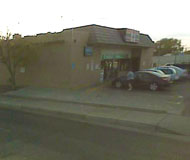Article from: www.thenewspaper.com/news/39/3920.asp
10/11/2012
New Mexico Supreme Court: Search Justified Because Passenger Dressed Like Prostitute
High court in New Mexico upholds vehicle search on grounds passenger looked like a prostitute.
 Police were right to search a vehicle carrying a passenger dressed like a prostitute, New Mexico's highest court declared in an August 30 ruling. The state Supreme Court did so to reinstate the conviction of Gunnar Olson, who was arrested December 1, 2007 after being searched by Albuquerque Police Officer Trey Economidy. At around 12:30am, Economidy spotted Olson driving behind a 7-11 convenience store at the intersection of University Boulevard and Central Avenue. He found Olson's behavior suspicious.
Police were right to search a vehicle carrying a passenger dressed like a prostitute, New Mexico's highest court declared in an August 30 ruling. The state Supreme Court did so to reinstate the conviction of Gunnar Olson, who was arrested December 1, 2007 after being searched by Albuquerque Police Officer Trey Economidy. At around 12:30am, Economidy spotted Olson driving behind a 7-11 convenience store at the intersection of University Boulevard and Central Avenue. He found Olson's behavior suspicious.
"The vehicle pulls in the alley, doesn't conduct any business in the alley, kind of sees me in my marked police unit, kind of gives me the impression like, 'Oh, no, the police,' then backs out and then heads back southbound," the officer testified.
Economidy performed a traffic stop, pointing to an expired registration sticker as a pretext. To the officer, it was "pretty obvious" that the passenger was a transvestite prostitute based on clothing and "the heavy makeup." He had seen the passenger before. For that reason, he ordered both Olson and the passenger out of the car so they could be separately questioned to verify whether their stories would match. Olson said he was just giving "Emily" a ride. When asked for his driver's license, Olson reached for his fanny pack. Economidy insisted on searching it first for reasons of officer safety. He found three crack pipes, and a more expansive investigation turned up a small amount of crack cocaine. Olson was convicted on drug charges, but the state Court of Appeals threw out the evidence because the search could not be justified based on Officer Economidy's observation of Olson's driving in the alley.
"In the present case, the officer quickly focused his investigation on prostitution because of the passenger's identity and the passenger's clothing and makeup," the three-judge appellate panel ruled on April 8, 2011. "These very limited circumstances are insufficient to meet the standard of reasonable and articulable suspicion that defendant had knowingly hired or offered to hire his passenger to engage in a sexual act. Were we to hold otherwise, police officers would have carte blanche based on suspicion of solicitation of a prostitute to stop any vehicle late at night whenever he saw a driver and a known prostitute in the vehicle, to require the driver to exit the vehicle, and to question the driver and the passenger regarding their relationship. That conduct, no different than the conduct in the present case, is tantamount to a seizure of a driver based on the mere presence of a passenger known to have committed a past criminal act."
Four of the five state Supreme Court justices disagreed, insisting all of the factors taken together amounted to reasonable suspicion.
"While we share the Court of Appeals' concerns that police officers should not be allowed to arbitrarily stop and harass individuals merely because the individuals may associate with known criminals, this case does not present those circumstances," Justice Charles W. Daniels wrote for the high court. "The officer was required to have reasonable suspicion for expanding the traffic stop into an investigation of prostitution solicitation, and the record supports the district court's finding that the expansion was justified by reasonable suspicion."
The high court concluded that the evidence against Olson should be admitted. A copy of the case is available in a 210k PDF file at the source link below.
Source: New Mexico v. Olson (New Mexico Supreme Court, 8/30/2012)
Permanent Link for this item
Return to Front Page
 Police were right to search a vehicle carrying a passenger dressed like a prostitute, New Mexico's highest court declared in an August 30 ruling. The state Supreme Court did so to reinstate the conviction of Gunnar Olson, who was arrested December 1, 2007 after being searched by Albuquerque Police Officer Trey Economidy. At around 12:30am, Economidy spotted Olson driving behind a 7-11 convenience store at the intersection of University Boulevard and Central Avenue. He found Olson's behavior suspicious.
Police were right to search a vehicle carrying a passenger dressed like a prostitute, New Mexico's highest court declared in an August 30 ruling. The state Supreme Court did so to reinstate the conviction of Gunnar Olson, who was arrested December 1, 2007 after being searched by Albuquerque Police Officer Trey Economidy. At around 12:30am, Economidy spotted Olson driving behind a 7-11 convenience store at the intersection of University Boulevard and Central Avenue. He found Olson's behavior suspicious.